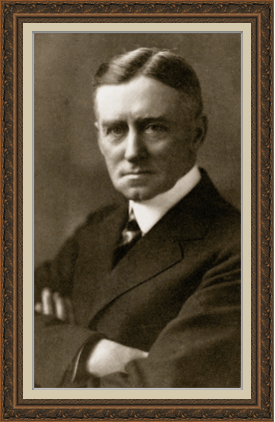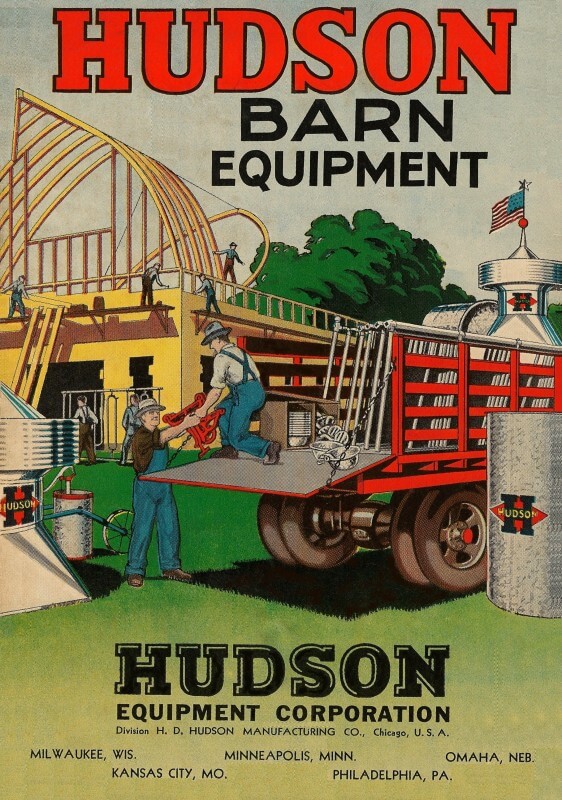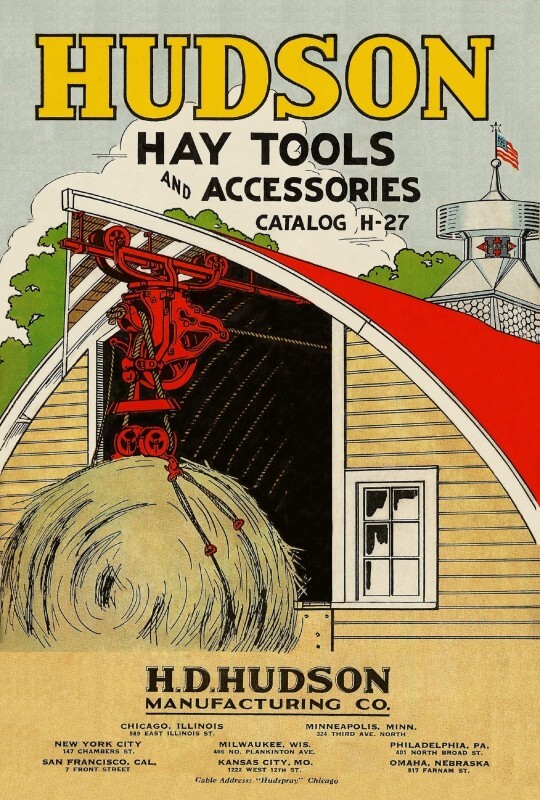
Headquarters:
Chicago, IllinoisAlso sold under the names (if applicable):
History:
Herbert DaVince (H. D.) Hudson (1861 – 1943)
Herbert DaVince (H. D.) Hudson was born in a log cabin in Michigan on Jan. 20, 1861. He was to become one of the founders of the Hudson & Thurber Company – from which the H.D. Hudson Manufacturing Company evolved.
Herbert attended rural school, studying at night by candlelight. As a young man, he helped on the family farm and taught school and music. At age 22, he decided to leave the farm, determined there were other ways he could provide a better life for his family and perform more useful public service. He worked for a time unloading farm implements from rail cars and assembling them for dealers. As the turn of the century was approaching, Herbert took an earnest look at the plight of the working man; and after further studies and a year at a business college; he decided he could better earn a living selling rather than assembling agricultural implements. He took up employment with the Milwaukee Harvester Company of Wisconsin and with that new direction, H.D. and his wife Delia settled into their modest home near Battle Creek, Michigan. There they had four children; a girl and three boys. Their youngest child, born on Jan.18, 1900, was Robert Clive Hudson destined to become the second president of H.D. Hudson Manufacturing Company.
H.D. longed to own his own business and in 1903 that opportunity came when he purchased the Minneapolis Tubular Well & Supply Company, which manufactured water well supply goods. In 1905, he moved his family to Minneapolis where he met and became close friends with Miles S. Thurber, who also had entrepreneurial ambitions. Together, they pooled their resources and purchased the Twin City branch of R. Herschel Manufacturing Company, of Peoria, Ill.; a company manufacturing agricultural supplies such as mowers and binder repair parts.
Hudson combined Minneapolis Tubular and Herschel Manufacturing and incorporated them as the Hudson & Thurber Company on Sept. 1, 1905. Within a few short years it grew to become the largest distributor of agricultural supplies in the Northwest. With a sales force of 35 to 40, it served several thousand dealers in Wisconsin, Minnesota, Northern Iowa, Nebraska, North and South Dakota, Montana and part of Wyoming.
H.D. Hudson always had a keen desire to manufacture the merchandise he sold, so he could better control deliveries and maintain quality of the products. His basic policy had been to supply the best products for the purpose desired; to supply them at a reasonable price; to guarantee the quality and fitness of the merchandise he sold; and to stand squarely behind every statement and activity of the corporation.
His rule was to satisfy the customers and provide them with the best articles for the purposes intended – principles that continued to guide the company for decades.
In 1906, with new opportunities abounding, H.D. Hudson decided the time was right to make the move into manufacturing and purchased the Brandt Manufacturing Company of Chicago City, Minn. Brandt manufactured small compression sprayers for the farmers in the Red River Valley to protect crops against insects
and diseases. In 1909, the Brandt plant was moved to a small, two-story building in Hastings, Minn. with a workforce of four men producing sprayers from a single pattern. Hudson & Thurber’s move into sprayer manufacturing was a success and in 1912 they made their move into the power sprayer market by purchasing the American Sprayer Company of Minneapolis. The business continued in Minneapolis under the Brandt name until 1914 when it was moved to the Hastings factory site which had been rebuilt after being destroyed by fire a year earlier.
In 1913, Hudson & Thurber had purchased the DeFrees Manufacturing Company of Minneapolis, a manufacturer of air compressors. This business continued at that location
for many years. Their Henry & Allen branch at Omaha, Neb., was also purchased in 1913 and set up as the Hudson Omaha sales and service office and warehouse to better serve dealers in that area.
On the heels of the major acquisitions Hudson & Thurber made in 1913, the company bought the Kenyon Manufacturing Company of Minneapolis the following year. Also in 1914, they purchased the auto accessory business of Pence Automobile Company, Minneapolis, a company in the new and growing automobile market; which put Hudson in the business of making auto tops, side curtains and radiator covers, none of which were standard equipment on cars of the time.
A testament to the company’s broad interests, Hudson & Thurber Company issued its first barn equipment catalog Right-Way Barn Equipment, in 1914. It included stanchions, stalls, mangers, water bowls and roof ventilation equipment and in 1914 they issued Catalog D and to illustrate their company growth, the Hudson & Thurber Company was billed as “manufacturers and wholesalers of implement and thresher supplies, hardware specialties, pumps and water systems, well supplies and a complete line of compressed air and hand sprayers, bucket and barrel pumps, and wheelbarrow sprayers.”
When Hudson started in the sprayer and duster industry, there were only a few organic chemicals available. Although most growers used these chemicals to control insects and diseases on fruit and berries, fewer than 20 percent used them on their field and row crops. Farmers who did not use chemicals, controlled insects on potato, cotton and other
plants using a much more primitive method that involved knocking the pests into a can of kerosene and burning them.
In 1916 the Kegler Manufacturing Co. of Waterloo, Iowa was purchased and consolidated with the Hudson sheet metal factory in Minneapolis to help satisfy the market for stock tanks and cupolas. Around this same time, M.S. Thurber decided to leave the business. Hudson and others bought out his interest.
Catalog B-12 of Right Way Barn Equipment was issued in 1917. It featured lever-operated stanchions, which Hudson pioneered. During this time, even as the U.S. plunged into World War I and strains were imposed on all businesses (heatless days, power limitations, shortages of material, etc.) H.D. Hudson’s company was able to continue its growth and expansion. In 1918, the American Culvert Company of Albert Lea, Minn., which manufactured cupolas, was acquired to expand Hudson’s sheet metal products. To enlarge the barn equipment line and provide better manufacturing facilities, the Western Steel and Iron Works, of De Pere, Wis., was purchased in 1919. Manufacture of all the barn equipment was then concentrated at this location. The plant grew to be one of the most efficient in the field, and Hudson grew to become one of the important suppliers of barn equipment.
The company entered the garden tool business with the purchase, in 1919, of the Pull-Easy Manufacturing Company of Waukesha,Wis., manufacturers of hand cultivators and dandelion and lawn rakes. It also purchased F. Blocki Company of Sheboygan, Wis., which manufactured wheeled garden seeders, cultivators and high-wheel plows. Both companies were transferred to Hastings for production. As a result, Hudson’s 14th Annual Catalog in 1919 featured sprayers and dusters, garden tools, coaster wagons, carrying carts, tire pumps, barn and livestock equipment.
Expansion continued in 1920 with the purchase of Nelson Manufacturing Company, Deerfield, Wis., manufacturers of tank heaters. This line was consolidated with production of sheet metal products in the Minneapolis tank factory. The Strickler Hay Tool Company, Janesville,Wis., which manufactured a line of hay tools and accessories, was also purchased in 1920. This business was moved to De Pere, Wis., where it was combined with production of barn equipment. The 1920 Catalog 15 was issued showing a complete line of “Hudson-made and guaranteed products” and featuring a picture of H. D. Hudson, The Man Behind The Goods. In 1921, “The” was added to the company’s corporate name, thus it became The Hudson Manufacturing Company
As the company began covering a greater geographic territory, new offices were established. In 1921, a sales office was opened in New York City. In 1922, a sales office and warehouse were established in Philadelphia, and a sales office was opened in Kansas City, Mo. In the 1920s, H.D. Hudson, an ardent patriot, felt that people, especially school children, should honor their country’s flag and respect it. Through his salesmen, working with dealers in communities throughout the Midwest, the company offered to donate and put up new flagpoles at schools and cemeteries. The flagpoles were made of pipe from the Pump and Well Supply Division. A bronze plaque, with appropriate sentiment, was also donated.
The decade from 1925 to 1935 was a time of growth and expansion for The Hudson Manufacturing Company, but it also represented a change in the nature of the business, with manufacturing becoming its primary objective. Further acquisitions of smaller manufacturers brought additional items to complement the company’s lines; they provided improved production facilities, and enabled the company to expand its growing markets for barn equipment, sheet metal products, poultry equipment, pumps, water systems, sprayers and dusters. In 1925, the C.A. Libbey Company of Oshkosh, Wis., another small manufacturer of barn equipment, including hay trolleys, was purchased; and Hudson issued Catalog G, which featured farm equipment, repairs and supplies, and presented a full line of Hudson-made products for the farm.
provided improved production facilities, and enabled the company to expand its growing markets for barn equipment, sheet metal products, poultry equipment, pumps, water systems, sprayers and dusters. In 1925, the C.A. Libbey Company of Oshkosh, Wis., another small manufacturer of barn equipment, including hay trolleys, was purchased; and Hudson issued Catalog G, which featured farm equipment, repairs and supplies, and presented a full line of Hudson-made products for the farm.
Hudson’s current corporate trademark design, combining a diamond and an H, known as the “Diamond H,” was introduced in 1927. In 1949, the slogan, “Sign of the Best Buy,” was added to the mark. Though most people may think corporate branding is something new, in 1928, Hudson was already building a brand around its founder. The 1928 Sprayer Catalog, No. S23, told for the first time the story of H.D. Hudson’s life and included the picture of the log cabin where he was born. On April 1, 1929, to support the company’s activities as a manufacturer selling products throughout the United States and overseas, the company’s general office was moved to Chicago at 589 East Illinois Street. With the move to Chicago, the corporate name was also modified to H. D. Hudson Manufacturing Company to avoid confusion with another company.
Farm equipment continued to be a large part of H.D. Hudson’s business. Catalog 153 was issued in 1929, and covered farm buildings designed and equipped by Hudson. It had complete building plans showing a full line of equipment. It also featured Hudson’s factory-assembled stalls that offered economy in shipping and greater convenience in installing. The first complete Catalog of Poultry Equipment, PE-1 was also issued in 1929. It featured the Kleen-Ezy Line and introduced the first Hudson coal-burning brooder.
In 1931, Barn Equipment Catalog B-26, with the slogan “Farm Tested and Proved,” introduced Hudson’s first milking parlor stalls. It also featured Hudson’s new fused aluminum finish, a superior protective coating for steel and iron that preserved the original appearance and greatly lengthened the service life of stanchions, stalls, pens and other equipment. Catalog LG-26 was published the same year, featuring Hudson lawn mowers, garden tools, coaster wagons and farm accessories. Also in 1931, Catalog H27, Hudson Hay Tools and Accessories,was published. It carried the warning: “Do not buy your hay carrier equipment on a competitive bid of price. Buy only on a competitive bid of service and quality; not how many dollars, but how many years of satisfactory and uninterrupted service.”
The Hudson Company made it through the depression years of 1931-33 by tightening its belt, conserving its assets, and continuing to fight for business and a bigger share of the market. With the onset of WW II, the H.D. Hudson Company quickly and actively engaged in its contribution to the war effort, producing items needed for the American military and its allies and to ensure the safety of the food supply – a responsibility it carried with great pride. Hudson’s sprayer and duster factory at Hastings was taken completely out of production for civilian needs for over two years. During that time, it manufactured various patterns of sprayers and dusters for the armed services under high priorities, producing patterns that fully met the strict standards the armed services had set. Perhaps the most gratifying aspect of this assignment was the part Hudson sprayers and dusters played in decontamination and in protecting the lives and health of our men in service (and civilians in foreign countries) from deadly diseases.
In 1943, the company suffered a great loss with the death of its founder and President, H.D. Hudson, the “Man Behind The Goods.” R. C. Hudson, H.D.’s son, who had been active in the business in all its phases since 1932, was elected president and treasurer. Under his leadership and direction, the corporation entered a new period of development and expansion in the post WW II era. As the materials situation eased and the population growth demanded more homes, cars and better transportation facilities, a tremendous expansion followed in both urban and suburban living. This greatly expanded the market for lawn and garden equipment including hand and power sprayers.
In the decades that followed, the H. D. Hudson Manufacturing Company, under the leadership of H.D. Hudson’s descendants, would continue to thrive and grow; not just in the sprayer and duster venue, but in the poultry equipment arena as well as stock feeders and waterers and hog raising systems.
In 1962, Rachel Carson’s book, “Silent Spring,” received substantial publicity on the belief that pesticides can build up in soil and become harmful. The H. D. Hudson Manufacturing Company increased its ongoing efforts to inform the public, and especially the home gardener, on the need and value of pesticides and of proper application. As early as 1917 the company had been mindful of proper use, storage and application of chemicals and included handbook sections in their catalogs.
Hudson was ever expanding their international markets and in March 1972, H.D. Hudson Trading, Inc., a wholly owned subsidiary, was formed as a domestic international sales corporation. This operation was designed to help Hudson secure a greater share of export business.
As changing economies and consumer demands have evolved, so too has H.D. Hudson Manufacturing Company. Today, a world leader in producing sprayers and dusters; not just for the homeowner but for the commercial and industrial needs as well. Strategies such as marketing direct to the “big box” stores has resulted in continued sales records and growth. In 2005, Hudson marked its 100th year of serving and providing value to customers around the globe. Few companies reach that milestone, much less family-owned corporations!
Source: Article by Dennis Mcgrew